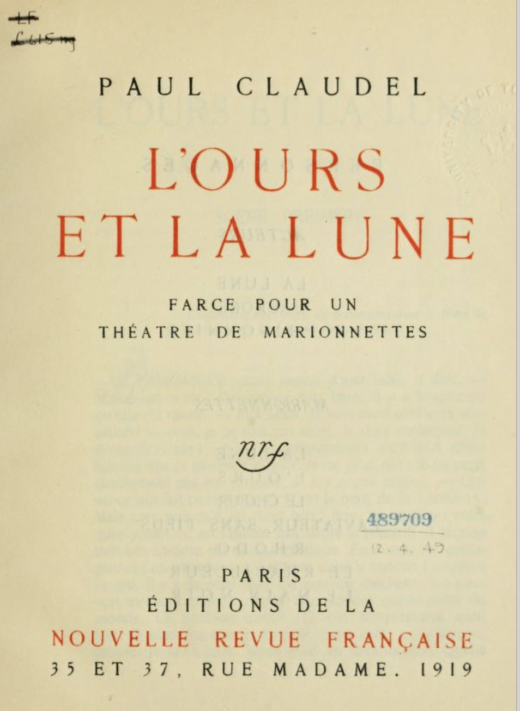
Printed
79 pages
L'Ours et la lune
Paul Claudel wrote this farce for puppets during the First World War, in collaboration with Darius Milhaud who worked on the music. He wrote it in Rio de Janeiro during his first stay as ambassador of France in Brazil. The play is made of four scenes, and the last three are played with puppets.
These three scenes are farces, each leading to the next and creating a chain that leads back to the first farce. The farces teach the virtues of renunciation in order to feel free.
A man dreams
The first scene is set in the infirmary of a prisoner camp in Germany, at midnight, during the First World War. A French prisoner thinks about his lost loved ones: his wife, his son Jean (a pilot who died in combat), and his grand-children who were left orphans. At that moment arrives the Lune (Moon), “the Queen of Dreams”; she takes him to the land of dreams, and shows him a nursery in Hostiaz.
The second scene introduces an Ours en peluche (teddy Bear) sleeping on a child’s bed. The Lune addresses the Ours and during their conversation we learn that the Ours is in fact a shady businessman who fled to South America after ruining his shareholders. In vain, the Lune tries to convince the Ours to return the stolen money (represented by a diamond hidden in the Ours’ belly). She then starts sharing her heartbreaks: she is in love with Paul, a pilot who was amputated of both his legs. Having learnt of the Lune’s wealthiness, the Ours offers his services to help her gain the Aviateur’s (Pilot’s) love.
Paul opens the third scene, which is set in a living room, where he is with another character, the Rhabilleur (Clock restorer). The Lune tries to seduce Paul but he is the object of the Ours’ mockeries because he received a break-up letter from his fiancée. The Ours tries, in vain, to convince Paul to find comfort with the Lune. We learn that Paul is the brother-in-law of Jean, the dead pilot and son of the prisoner who appeared in the first scene.
A certain Rhodô, who is in love with Jean, took care of the children. The Ours decides to marry Paul to Rhodô because he is attracted to her, but she stays faithful to Jean. The Ours then tries to kiss Rhodô to get hold of her wallet. This triggers a general fight during which the Ours, with his belly ripped open, lets the diamond slip – it explodes in a blinding light. As the sun rises, all the characters run away.
The fourth scene starts. All the puppets are on the main road. The Ours feels light now that he is rid of the diamond. The Choeur (Choir) and Rhodô teach Paul how to float in the air like a kite. A black dwarf arrives, driving a car. The puppets all climb into the car and drive off to a world beyond.
The play ends at dawn with the Prisonnier (Prisoner) waking up. After having experienced the bliss of mystical freedom in his dream, he is now condemned to go back to this “eternal captivity”.
First performance
Théâtre du Kaléidoscope, staged by Dominique Houdart
Publications and translations
La Nouvelle Revue française, Gaston Gallimard, Paris, 1919.